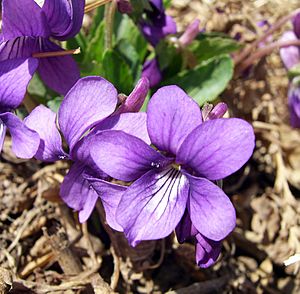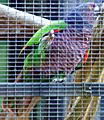Violet (color) facts for kids
| This box shows the color violet. |
|---|
Violet is a beautiful color often seen in nature. It's the sixth color you see in a rainbow, right on the inside edge. Violet is found between blue and purple on the color spectrum. The name "violet" comes from the small, pretty violet flower, which grows in many parts of the world.
People started using "violet" as a color name in the English language way back in 1370.
Contents
What's the Difference Between Violet and Purple?
Violet and purple are often confused, but they are actually different!
- Violet is a real color of light, just like blue or red. It has its own place in the electromagnetic spectrum, which is the range of all types of light.
- Purple is a mix of red and blue light. It's not a single color on the spectrum.
- Think of it this way: you can see violet light in a rainbow. You won't see pure purple light in a rainbow because it's a mixed color.
Violet in Nature
Violet is a common color in the natural world, especially in plants and animals.
- Many flowers, like lavender, irises, and of course, violets, show off this lovely color.
- Some animals also have violet colors, like the violet-backed starling bird or the purple sea urchin.
Violet in Art and History
Violet has been used in art and clothing for a very long time.
- In the past, making violet dyes was difficult and expensive. This meant that violet clothing was often worn by royalty or very important people.
- Artists have used violet to create different moods in their paintings. For example, James McNeil Whistler used violet to show a winter scene.
- The Wilton Diptych, a famous painting from 1395, shows King Richard II with violet colors.
- In the 1800s, new ways to make dyes made violet more common. This made it a popular color for fashion.
Images for kids
-
Five presidents in the oval office. The two more recent presidents, George W. Bush and Barack Obama, are wearing violet ties.
-
A Japanese woman in the kimono style popular in the Heian period (794–1185) with a violet head covering.
-
The Susan B. Anthony stamp (1936), was the reddish tone of violet known as red-violet since violet was a color that represented the Women's Suffrage movement.
-
In amethyst, the violet color arises from an impurity of iron in the quartz.
-
The marine hatchetfish (here eating a small crustacean) lives in extreme depths.
-
The purple sea urchin.
-
The violet carpenter bee (Xylocopa violacea) is one of the largest bees in Europe.
-
The violet-backed starling is found in Sub-Saharan Africa.
-
The violet sabrewing is found in Central America.
-
The imperial amazon parrot is featured on the national flag of Dominica, making it the only national flag in the world with a violet color.
-
Lobelia flowers.
-
Crocus flowers.
-
Lilac flowers.
-
Pansy flowers.
-
Sweet violet flowers.
-
Wisteria blooms are a light violet color.
-
An eggplant.
-
The Wilton Diptych (1395), painted for King Richard II.
-
Charles de Bourbon, the future King Carlos III of Spain (1725).
-
Portrait of Empress Catherine the Great of Russia, by Fyodor Rokotov. (State Hermitage Museum).
-
In England, Pre-Raphaelite painters like Arthur Hughes loved purple and violet. This is April Love (1856).
-
Nocturne: Trafalgar Square Chelsea Snow (1876) by James McNeil Whistler, used violet to create a wintery mood.
-
Portrait of Caroline Remy de Guebhard, by Pierre-Auguste Renoir (1841–1919). Mauve became a popular fashion color after the invention of the synthetic dye in 1856.
-
Irises by Vincent van Gogh (1889), Metropolitan Museum of Art.
-
The Starry Night, by Vincent van Gogh (1889), Museum of Modern Art.
See also

































 In Spanish:
In Spanish: